Regionalism refers to the process of collaboration and integration among countries within a particular geographic region, typically aimed at enhancing economic, political, and social cooperation. It may manifest in various forms, from free trade agreements and common markets to political unions and security arrangements. The two major examples of regionalism in the world—South Asia and Europe—offer interesting contrasts in terms of their objectives, institutional frameworks, economic integration, and political dynamics. This comparative analysis seeks to explore the key similarities and differences between regionalism in South Asia and regionalism in Europe, focusing on their evolution, successes, challenges, and the role of international organizations like the European Union (EU) and the South Asian Association for Regional Cooperation (SAARC).
1. Historical Context and Evolution
- Europe: Regionalism in Europe has its roots in the aftermath of the two World Wars and the desire to prevent further conflict in the region. The idea of European integration began with the European Coal and Steel Community (ECSC) in 1951, which was aimed at pooling coal and steel resources to prevent future wars. This was followed by the creation of the European Economic Community (EEC) through the Treaty of Rome in 1957, which sought to create a common market among six founding countries. Over time, the EEC evolved into the European Union (EU) through successive treaties, including the Maastricht Treaty (1992) and the Lisbon Treaty (2009). The EU now encompasses a wide range of areas such as economic integration, political cooperation, security, and foreign policy.
- South Asia: South Asia, a region comprising countries like India, Pakistan, Sri Lanka, Bangladesh, Nepal, Bhutan, and the Maldives, has a much more complex historical backdrop. The region has experienced colonialism, territorial disputes, ethnic and religious tensions, and diverse political systems, which have hindered deeper regional integration. The formation of the South Asian Association for Regional Cooperation (SAARC) in 1985 was an attempt to foster regional cooperation, particularly in economic and social spheres. However, SAARC has not achieved the level of integration seen in Europe, largely due to political conflicts, especially between India and Pakistan, and the region’s wide socio-economic disparities.
2. Institutional Framework and Objectives
- Europe: The institutional framework for European regionalism is well-established and sophisticated. The European Union (EU) serves as the primary institution for promoting economic, political, and social integration. The EU’s objectives include the establishment of a single market, free movement of people, economic cohesion, and the promotion of peace and stability across the continent. The EU is governed by major institutions, including the European Commission, European Parliament, European Central Bank (ECB), and European Council. The EU also has a strong legal framework, with binding laws and regulations that govern its member states. Over time, the EU has expanded its reach to include foreign policy coordination, security cooperation, and even military defense.
- South Asia: In contrast, SAARC lacks the institutional depth and binding mechanisms that characterize the EU. Its primary objective is to promote regional cooperation in areas such as economic development, poverty reduction, health, and education. SAARC has created some regional initiatives, such as the South Asian Free Trade Area (SAFTA), but these have had limited success. SAARC is often criticized for its lack of institutional capacity, absence of strong legal frameworks, and difficulty in achieving consensus among its members. The lack of binding authority and the absence of a clear institutional mechanism for enforcement make it difficult for SAARC to address complex regional challenges effectively.
3. Economic Integration
- Europe: The EU is the most advanced example of economic integration globally. It has created a single market where goods, services, capital, and people move freely across national borders. The introduction of the Euro as a common currency in 19 out of 27 EU countries has further deepened economic integration. The EU also has common trade policies, customs unions, and a shared competition policy. The European Single Market has led to significant economic growth, stability, and increased intra-regional trade among EU member states. Additionally, the EU budget plays an important role in funding regional development, particularly in less developed member states.
- South Asia: Economic integration in South Asia has been slow and fragmented. SAARC’s flagship initiative, SAFTA, aims to create a free trade area in the region, but the progress has been hindered by trade barriers, non-tariff restrictions, and bilateral conflicts between member states. Countries like India, Pakistan, and Bangladesh have different levels of economic development, which has created challenges in harmonizing trade policies and aligning economic interests. While India is the dominant economic power in the region, its relationship with its neighbors, especially Pakistan, has remained strained, making deeper economic cooperation difficult. The region is also highly dependent on trade with external partners, particularly China and the United States, rather than fostering intra-regional trade.
4. Political Cooperation and Challenges
- Europe: Political cooperation in the EU is anchored in the idea of shared sovereignty. Member states have ceded some degree of sovereignty to the EU institutions in areas such as foreign policy, security, and economic governance. The EU promotes democracy, human rights, and the rule of law, both internally and externally. However, political cooperation in Europe is not without challenges. Issues such as the migration crisis, economic inequality, and Brexit have tested the EU’s cohesion. Nevertheless, the EU’s commitment to deeper political integration remains strong, and the EU has been able to respond collectively to crises in ways that other regional organizations have not.
- South Asia: Political cooperation in South Asia is undermined by historical conflicts and political rivalries. The relationship between India and Pakistan remains the most contentious issue in the region, with both countries involved in territorial disputes, particularly over Kashmir. These tensions have prevented SAARC from developing into a cohesive political bloc. Additionally, the region’s political systems are diverse, ranging from democracies like India and Sri Lanka to monarchies like Bhutan. As a result, political cooperation within SAARC has been sporadic and often undermined by national interests and disputes.
5. Security and Geopolitical Issues
- Europe: The EU has made significant strides in security cooperation, with the Common Foreign and Security Policy (CFSP) and the Common Security and Defence Policy (CSDP) playing crucial roles in shaping Europe’s response to global crises. The EU also works closely with NATO (North Atlantic Treaty Organization) to address security challenges in the region. The EU has been an important actor in conflict resolution, peacekeeping, and humanitarian efforts, particularly in regions like the Balkans and the Eastern Mediterranean.
- South Asia: In South Asia, security concerns are more pronounced, particularly due to the presence of nuclear-armed powers like India and Pakistan. Regional conflicts, terrorism, and cross-border tensions have hindered effective security cooperation. SAARC has been unable to create a unified approach to regional security, partly due to the lack of trust and cooperation between member states. Furthermore, the influence of external powers, such as China and the United States, complicates regional security dynamics, with China’s growing presence in South Asia raising concerns in India.
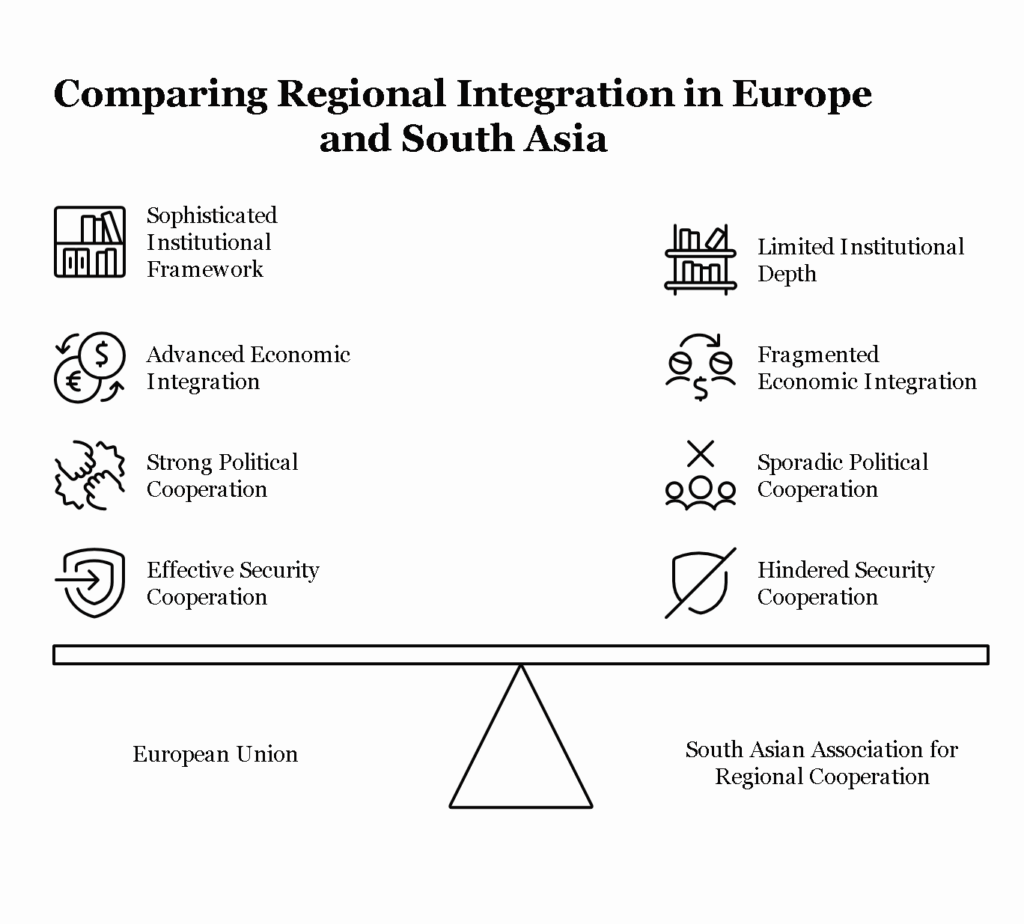
Conclusion
Regionalism in South Asia and Europe presents contrasting models of integration, with Europe being a successful example of economic, political, and security cooperation, while South Asia remains largely fragmented in its approach. The EU has achieved remarkable progress in creating a single market, promoting democracy, and fostering political cohesion, despite challenges like Brexit and migration. In contrast, SAARC has struggled with political conflicts, economic disparities, and geopolitical tensions, which have limited its effectiveness. The differences in historical context, institutional development, and political dynamics highlight the challenges and opportunities for regionalism in these two regions.



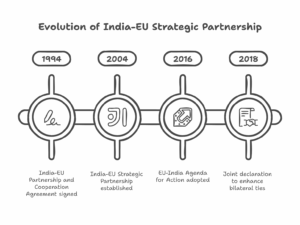
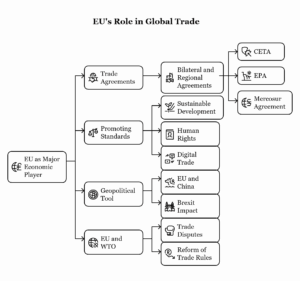
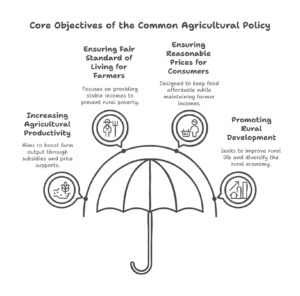
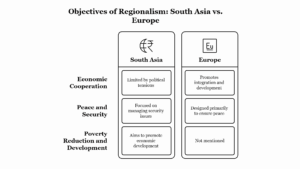

Leave a Reply